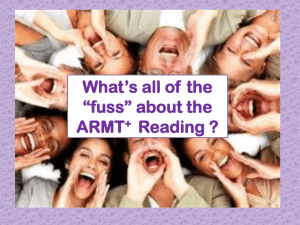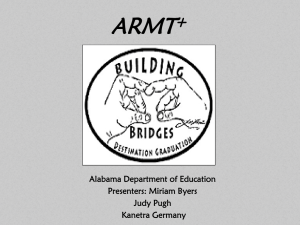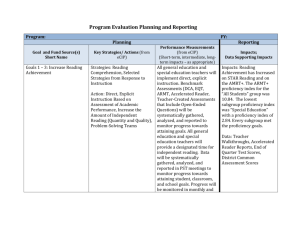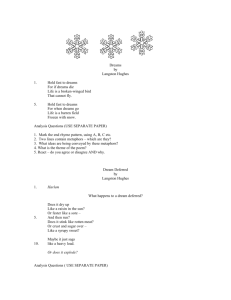Scoring Guidelines ARMT Open
advertisement
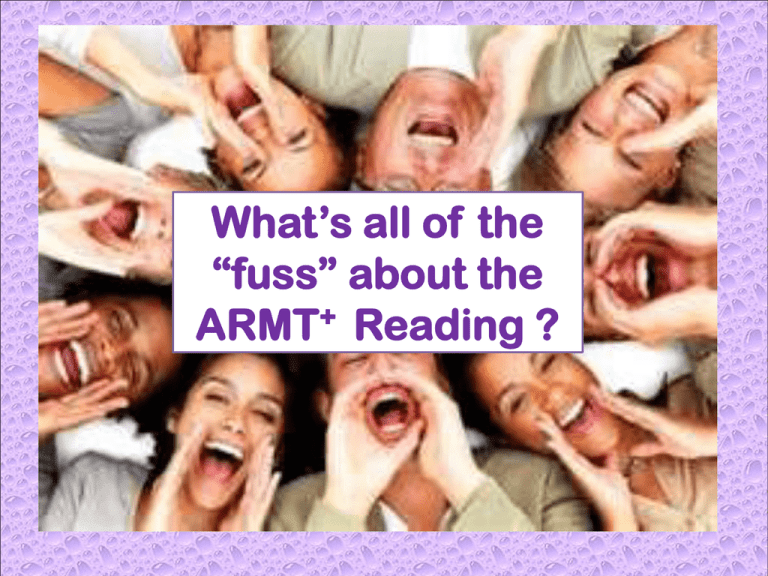
What’s all of the “fuss” about the ARMT+ Reading ? Objectives • To provide an overview of ARMT+ Reading, including item difficulty, new item formats, and sample test questions. • To suggest strategies to improve reading comprehension instruction across the curriculum. Blueprints ARMT Types of Reading Assessed Literary/recreational stories and poetry Textual/informational subject texts Functional manuals, brochures, etc. Item Types ARMT Multiple Choice Questions • Stand-alone questions • Passage-based questions – Key words underlined (Grade 3) – Key words italicized (Grades 4-8) Item Types ARMT Open-ended Questions Scoring Guidelines ARMT Multiple Choice Questions Valued at one point each Scoring Guidelines ARMT Open-ended Responses • Open-ended Responses – Valued at 3 points each • Score point 3demonstrates a thorough understanding • Score point 2demonstrates a general understanding • Score point 1demonstrates a limited understanding • Score point 0- no attempt to address the prompt Scoring Guidelines ARMT • Open-ended Responses must… – Address the question by including details and examples from the passage for support. – Be legible. – Stay within the confines of the box. Item Format Item Format ARMT+ • Passages may be 1-2 pages in length. • All multiple choice questions have four choices. • All open-ended response questions have consistent wording. RIGOR What is Rigor? • “Challenging all students with high expectations”(Gates Foundation Web site) • Active, deep, and engaging learning (Small Schools Project) • “Academic rigor is based on expectations established for students and staff that ensure that students demonstrate a thorough, in-depth mastery of challenging and complex curricular concepts. In every subject, at every grade level, instruction must include commitment to a knowledge core and the application of that knowledge core to solve complex realworld problems.” (North Carolina State Board of Education, 2005) (Edmunds 2006) Rigor Evaluation Creating Synthesis Evaluating Analysis Analyzing Application Applying Comprehension Knowledge Understanding Remembering Rigor • Increased vocabulary • Use of words such as mainly, most likely, probably, and best • Answer choices ( words, examples, or excerpts from passages and poems) • Comparisons (poem/poem, poem /passage, passage/passage, or chart [table, graph, etc.]/passage) • Previously used formats in upper grades may appear in lower grades. Rigor Open-ended Responses • Thorough – Specific – Multiple examples and support (list, portions of a conversation, line(s) from a poem(s), etc.) – All steps provided within a sequence of steps or events • General – Basic – Few examples and limited support (2 of 4 ideas listed, a word from a line in a poem, etc.) – Some steps provided within a sequence of steps or events • Limited – Vague or incomplete – One incomplete part of a two part question (compare, but does not contrast; a cause with no effect) – Random step(s) provided within a sequence of steps or events – Glimmer • No attempt to address the prompt Provide Opportunities to Talk/Write Everyday is a great day to allow your child to talk & write about their experiences. Types of Writing • • • • • • • • • Freewriting Journals Notetaking Questions Explanations Summaries Definitions Memos Letters Reviews Editorials Books Stories Poems Reports/ Research papers • Essays • Plays • • • • • • Global Tested Skills Non-exhaustive List • • • • • • • • Drawing conclusions Sequence of events/information Making inferences Fiction/nonfiction Fact/opinion Previewing/predicting Following directions Vocabulary Grade 4 • Vocabulary- Standards 2 and 3 • Comparing and Contrasting • Genres- novels, short stories, poetry, and trade books • Literary elements and devices- identify characters, similes, main idea, and author’s purpose • Using text features- titles, headings, glossary, boldface, index, table of contents, and tables • Use of bias/recognizing persuasive techniques • Notetaking Grade 4 ARMT Sample Grade 4 ARMT Sample Grade 4 ARMT+ Sample + Compare and contrast the Sun and the Moon. Use specific details from the story to support your answer. Write your answer in the answer document. Grade 5 • Vocabulary- Standards 1, 2, and 4 • Literary elements and devices- Recognize setting, character traits, stated purpose, metaphors, personification, and implied purpose(identify) • Tables and charts • Reference materials Grade 5 ARMT+ Sample Dreams Hold fast to dreams For if dreams die Life is a broken winged bird That cannot fly. Hold fast to dreams For when dreams go Life is a barren field Frozen with snow. Langston Hughes Grade 5 ARMT+ Samples Which line from the poem is an example of a metaphor? A. “Hold fast to dreams” B. “Life is a broken winged bird” C. “For when dreams go” D. “Frozen with snow.” What is the effect of the author’s use of images? Use details from the poem to support your answer. Write your answer in the answer document. Grade 5 ARMT+ Sample Which sentence shows possession? A. Johnny can’t reach the box on the top shelf. B. Jafaar’s books are in the brown backpack. C. Kenyatta didn’t call me last night. D. I’ve always combed my hair to one side. Prepare to Plan • Before anything else, preparation is the key to success. -Alexander Graham Bell • There are no secrets to success. It is the result of preparation, hard work, and learning from failure. -Colin Powell Contact If there are any questions feel free to contact me @ warren4reading@gmail.com 231- 5273

